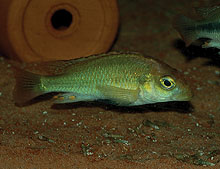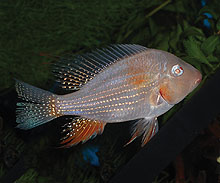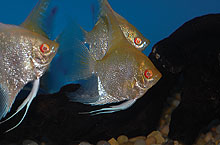Select date in side bar to go to a What's New of previous issues
| What's New
©by Laif DeMason
Well I’m back with my column again. The July issue just had too many good articles for me to squeeze in even one page! Not a problem for me. Over the last few months while traveling to different talks and visiting different stores in each place, I’ve come to the conclusion that American hobbyists keep a very wide selection of cichlids! That is good, as more species are bred by hobbyists, an increase in selection availability will result. Now if we can only develop a better system for some of the many ‘common’ names used for these uncommon species… Here’s “what’s new” on the cichlid scene: |
 Originally from the Ubwari Peninsula in Congo, Neolamprologus longicaudatus has been trickling in from various bred sources. The first name placed on the fish was “Ubwari buescheri” due to its superficial resemblance to the species found in the southern part of the lake; its lyre tail and long body. |
 Hobbyists also have been asking for wild Cyathopharynx recently. Some likely do not know that wild imports rarely, if ever, have even a little color and it takes months to regain it. Here an infrequently seen import, C. foae from Karilani Island, Tanzania. Also nicknamed the “Copper foai”. Photo by A. Konings. |
 Threatened in its natural habitat due to habitat degradation, the Julidochromis regani variety from Burundi. Fortunately a few years ago some were collected and are now in the capable hands of professional breeders. Photo by A. Konings. |
 Some prefer the extra jumbo size cichlids like this Oreochromis tanganicae. Once mature and fully colored, males do become quite beautiful. A further benefit is that you can eat this one when it outgrows its tank! |
 One nice thing about Lake Malawi, there are still many new cichlid species to be found! Recently an absolutely new Otopharynx species sold as “Blue Longnose” has been collected from the Tanzanian shore. This fish’s identification has even stumped our experts! Photo courtesy of OWEF. |
 Here an interesting man-made fish, a Sciaenochromis fryeri male with an OB pattern. I haven’t seen the females, but the males are an OB blue color without any red or orange hues, although it was likely developed from OB fish with these colors. |
 There are many Pundamilia varieties now circulating in the hobby, especially several named P. nyererei types. Here a male “Red Flank” nyererei offered by producers. I hope breeders and hobbyists alike will keep the several lines separate. |
 An interesting cichlid that made its way from European breeders, Enterochromis paropius or “Broken Line”. As far as Victorian cichlids are concerned, this fish has a peaceful disposition and is also differently colored with deep yellow hues. |
 A new albino strain of the threadfin acara, Acarichthys heckelii has been developed in the Far East. Certainly something different for hobbyists to keep. For the best finnage and display, only small dither fish should be used as tankmates. |
 The numerous fancy angelfish, Pterophyllum scalare, strains are big business for breeders. More interesting strains are rapidly being developed by mixing certain genes from other strains. Here an albino platinum angelfish. Note the red eye ring and pupil. |